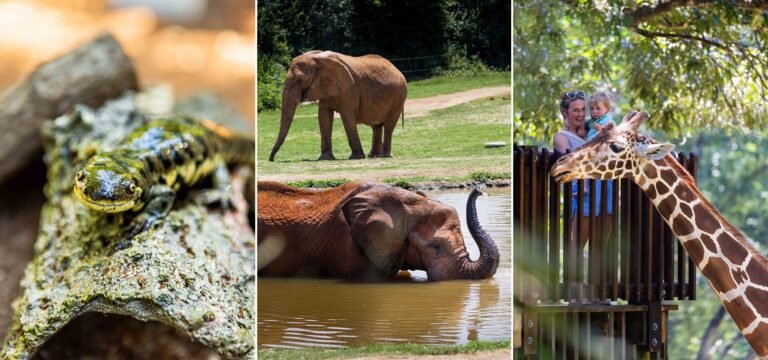are you considering a trip to the North Carolina zoo, one of the largest natural habitat zoos in the world? Planning the perfect visit can be an exciting yet overwhelming task, especially when trying to decide the best time to experience all that this incredible destination has to offer. With diverse wildlife, stunning landscapes, and seasonal events, timing your trip can significantly enhance your experience. Whether you’re hoping to avoid crowds, catch special exhibits, or enjoy the zoo’s stunning gardens in full bloom, understanding the seasonal nuances is key. In this article,we’ll guide you through the ideal times to visit,highlighting what makes each season unique. From lively summer days when animals are most active to the serene beauty of autumn leaves lining the pathways, join us as we help you find the perfect moment to make memories with family and friends at the NC zoo. Let’s embark on an adventure to discover the wonders that await!
Ideal Season for Wildlife viewing at NC Zoo
The North Carolina Zoo offers a spectacular array of wildlife viewing opportunities, making it an ideal destination for animal lovers throughout the year. However, certain seasons truly enhance the experience, allowing visitors to see creatures in their most active and vibrant states. Here are some key reasons why spring and early fall are notably captivating times to visit:
- spring Awakening: As temperatures rise, animals emerge from their winter slumber, and many species engage in courtship and breeding behaviors. Witnessing the birth of new life, from fluffy kangaroos to playful lion cubs, can be a heartwarming and enriching experience.
- Crisp Fall Days: The temperatures are cooler, making wildlife more active. This is a prime time to observe animals preparing for winter, whether that involves foraging or showcasing their vibrant autumn coats.
- Fewer Crowds: Visiting during these shoulder seasons often means experiencing the zoo with fewer visitors, allowing for a more intimate connection with the animals and less waiting time for exhibits.
- Special Events: Spring frequently enough features special events, such as “Meet the Keeper” days, which provide greater insights into animal behavior and care, enhancing your visit.
To help you plan your trip effectively, refer to the following table outlining seasonal highlights for wildlife viewing at the NC Zoo:
| Season | Wildlife Highlights | Best Viewing Times |
|---|---|---|
| Spring | Newborn animals, breeding behaviors | Morning hours (9 AM - 11 AM) |
| Summer | Active animals in cooler parts of the day | Late afternoons (3 PM – 5 PM) |
| Fall | Animals preparing for winter | Mid-morning (10 AM - 12 PM) |
| Winter | Winter adaptations, cozy habitats | Afternoon (1 PM – 3 PM) |
By visiting during these suggested times, you’ll be maximizing your wildlife viewing experience at the north Carolina Zoo, making it a memorable part of your Gezify travel adventures. Remember, each visit presents unique opportunities to connect with nature and witness the wonders of wildlife in a truly immersive habitat.
Plan your Visit During Spring or Fall for the Best Experience
To truly immerse yourself in the vibrant ecosystem of the North Carolina Zoo,consider timing your visit for the spring or fall months. During these seasons, the weather is pleasantly mild, creating an enjoyable backdrop for exploring the expansive exhibits. You can experience the zoo in full bloom during spring, when wildlife is active and plants are blossoming, or in the fall, when the foliage transforms into a breathtaking palette of colors. This not only enhances the visual experience, but also provides favorable temperatures for leisurely strolls and ample opportunities for wildlife watching. To maximize your experience, keep the following in mind:
- spring months (March to May): Witness the rejuvenation of nature, from blooming flowers to the lively antics of newly born animals.
- Fall months (September to November): The changing leaves make for stunning scenery while the cool air is perfect for outdoor activities.
- Mid-week visits: If possible, aim for days when the crowd is thinner, allowing for a more personalized experience with the animals.
- Special events: Check the zoo’s calendar for seasonal events such as animal encounters or educational programs that offer unique insights.
Additionally,planning your visit during these optimal months often means avoiding the sweltering summer heat or the biting cold of winter,which can impact both your comfort and the animals’ activity levels. A swift glance at the following table highlights some key factors to consider in your planning:
| Factor | Spring | Fall |
|---|---|---|
| Average Temperature | 60°F – 75°F | 50°F - 70°F |
| Animal activity | High | Moderate |
| Recommended Attire | Light layers | Layers with a light jacket |
No matter what season you choose, a visit to the NC Zoo promises remarkable moments, especially when planned around the transition of spring or fall. with Gezify’s tips, you’re well on your way to experiencing a magical adventure in the heart of North Carolina’s wildlife.
planning your visit to the North Carolina Zoo is all about timing and personal preference. whether you’re captivated by the vibrant colors of spring, enjoying summer’s lively atmosphere, or seeking a peaceful retreat in the fall, each season offers a unique experience. By considering factors like weather, wildlife activity, and seasonal events, you can tailor your trip for maximum enjoyment. Remember to check the zoo’s schedule for special activities, and don’t forget to take your time exploring the stunning habitats. Happy planning, and may your visit to the NC Zoo be unforgettable!
